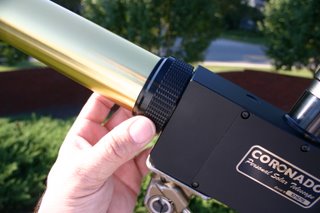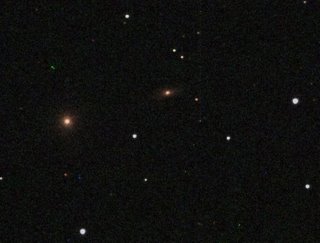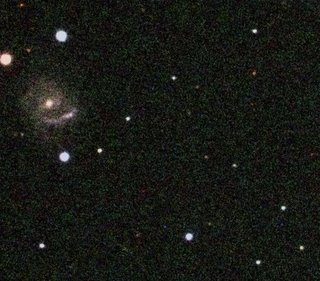2006-12-03
More on Arp's Peculiar Galaxies
SPIRAL GALAXIES
Arp 1-6 are low surface brightness galaxies. Click here to see an example.
Arp 7-12 are galaxies with split arms. Click here to see an example.
Arp 13-18 are galaxies with detached segments. Click here to see an example.
Arp 19-21 are three-armed spiral galaxies. I have not yet photographed an example of this category.
Arp 22-24 are one-armed spiral galaxies. I have not photographed any examples of these galaxies.
Arp 25-30 are spiral galaxies with one heavy arm. Click here to see an example.
Arp 31-36 are integral sign spiral galaxies. These are galaxies that look like astretched-out S shape, or like the integral sign used in calculus. Click here to see an example. I am not satisfied with any of the examples I have in this category, and plan to take better images soon.
Arp 37-48 are spiral galaxies with low surface brightness companions. Click here to see an example.
Apr 49-78 are spiral galaxies with small high surface brightness compainions. Click here to see an example.
Arp 79-91 are spiral galaxies with large high surface brightness companions. Click here to see an example.
Arp 92-101 are spiral galaxies with elliptical companions. Click here to see an example.
ELLIPTICAL AND ELLIPTICAL-LIKE GALAXIES
Arp 102-108 are elliptical galaxies connected to spiral galaxies. I have no image of this category -- yet.
Arp 109-112 are ellipitcal galaxies repelling sprial arms. Click here to see an example.
Arp 113-132 are elliptical galaxies close to and perturbing spiral galaxies. Click here to see an example.
Arp 137-145 are galaxies in which material appears to be emanating from the ellipitcal galaxy. Click here to see an example.
AMORPHOUS GALAXIES -- these are not spiral or elliptical.
Arp 146-148 are galaxies with associate rings. I am lacking an image from this category.
Arp 149-152 are galaxies with jets (material is being ejected outward from their nuclei) Click here to see an example.
Arp 153-160 are disturbed galaxies with interior absorption (hmmm, a peculiar galaxy that is disturbed?) Click here to see an example.
Arp 161-166 are galaxies with diffuse filaments. Click here to see an example. This is a poor example and I need to make better images of this category.
Arp 167-172 are galaxies with diffuse counter-tails. Click here to see an example.
Arp 173-178 are galaxies with narrow counter-tails. I have no example of this.
Arp 179-193 are galaxies with narrow filaments. Click here to see an example.
Arp 194-208 are galaxies with material ejected from nuclei. Click here to see an example.
Arp 209-214 are galaxies with irregularities, absorption and resolution. Click here to see an example.
Arp 215-220 are galaxies with adjacent loops. Click here to see an example. This is another category that I need to revisit, as this image is not very good.
Arp 221-226 are galaxies with amorphous spiral arms. Click here to see an example.
Arp 227-232 are galaxies with concentric rings. Click here to see an example. This is another category I want to revisit in order to take better images.
Arp 233-256 are galaxies with the appearance of fission. Click here to see an example.
Arp 257-268 are galaxies with irregular clumps. Click here to see an example.
DOUBLE AND MULTIPLE GALAXIES
Arp 269-274 are galaxies with connected arms. Click here to see an example.
Arp 275-280 are interacting galaxies. Click here to see an example.
Arp 281-286 are galaxies with infall and attraction. Click here to see an example.
Arp 287-293 are galaxies that appear to have "wind effects." Click here to see an example. I have two, very poor images of these galaxies -- I need to do more work here.
Arp 294-297 are double or multiple galaxies with long filaments. Click here to see an example.
UNCLASSIFIED
Arp 298-310 -- Arp did not give a subclassification to these objects. They are mostly interacting pairs. Click here to see an example.
Moon Watch - Sunrise Over Crater Babbage
Still, I decided to watch the sunrise today -- starting at 6 PM, ET -- and the sunrise was on the moon.
At 6 PM, 7 PM, 8 PM, 9 PM and 10 PM I took note of the changes sunrise brought to Crater Babbage, which is not far from the lunar limb, just beyond Sinus Iridium.
Here is the area at 6 PM. You can see Sinus Iridium very clearly as a dark area.
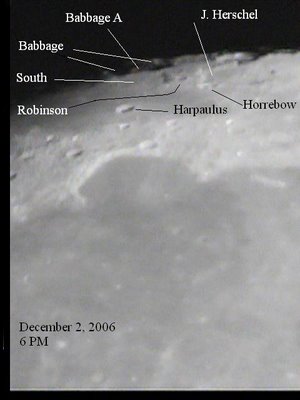
Crater Babbage is mostly a dark area, with only the southeastern (bottom on image) rim of the crater clearly visible. There is a hint of Crater Babbage A. At 6 PM, however, it is unclear whether Babbage is a crater. Babbage A might be a hill rather than a crater. Things become clearer at 7 PM.
At 7 PM (below), Babbage looks more like a crater, with the rim not quite complete, but nearly so. Babbage A is a complete crater. Crater South at 6 PM doesn't look like a crater at all, with just the eastern wall showing. Jump to 7 PM it is clearly a crater, although a shallow one.

Below is the 8 PM image. The difference between the 7 PM and 8 PM is not as great as the difference between the 6 PM and 7 PM images. Everything does continue to become clearer, but not much new is showing up.
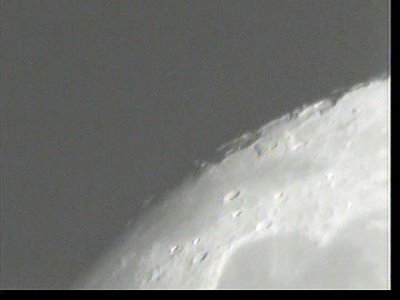
There is a jump in the difference between the images of 8 PM and 9 PM (the 9 PM images is seen below). The entire floor of Crater Babbage is visible and the rim of that crater is just barely complete in this light.
Clouds obscured a decent image at 10 PM, but visual observation showed (through clear patches in the clouds), that the crater rim was very complete. More detail could be seen on the floor of Babbage.
2006-11-30
Moon Watch -- Observing Cassini
“I sometimes do not recognize this old hand,” my father finally said, “and I wonder what happened to the smooth skin of my youth.”
Cassini is an aging area that hints at a more magnificent youth, but which has aged with grace and character.
Cassini is found on the edges of Mare Imbrium, the Sea of Rains, or the Sea of Showers, within a little area that calls to my mind the sub-continent of India, but which is known as Palus Nebularum. If one follows Plato and then moves along the Montes Alpes and beyond its end, the Promontorium Deville, there the observer will find Cassini.

The walls of Cassini itself are clearly seen, but at this lunation they seem to be ancient to the point of nearing extinction. The walls give the impression they what is seen is a remnant of what once was a more magnificent crater. The walls seem thin, and the floor of Cassini seems flooded with the same material that formed Mare Imbrium. Surrounding these thin walls are mountains and a roughness that must have once been part of a more youthful and dynamic Cassini Crater. Rather than having a central peak, as neighboring Aristillus possesses, or having a simple and flat flooring as does neighboring Archimedes, Cassini’s floor has an interesting collection of craters and craterlets.
It is the presence of newer craters that makes Cassini an interesting area to observe. These would have been formed after Cassini, and the intrusion of material from the formation of Mare Imbrium.
Cassini B is on the southwest edge, inside the crater. Cassini A is closer to the center, but a bit on the northeast. Cassini A seems a bit rough around the edges, and not quite circular in shape. Just outside of the Cassini walls is Cassini M. Further in the distance the observer will see F, C and E, but these move not only away from Cassini, but also away from Mare Imbrium and into a more rugged area.
Like all things that age, dignity is threatened. At this lunation, the thinning walls of Cassini seem strongest at the east, seeming to form a sort of silly grin. With Cassini B and Cassini M being at just the right angles and distance, these three appear to form two eyes and a grin – a silly, undignified “happy face” that detracts from the greatness of this feature.

2006-11-29
An Asteroid passing by Galaxy M77

On this second image, I indicated the movement of Triberga by adding some white pointer lines.

These photos will appear small on the blog, but if you double click the image you should see a larger view.
2006-11-08
Mercury Transit 2006

I was able to observe the Transit of Mercury today -- which means that Mercury appeared to move across the face of the sun. The first time I saw one was in 1971 -- I've also seen the transits in 1993, 1999, and 2003. The next one will be on May 9, 2016.
With the Mercurian year so short, it would seem that the planet would appear to pass across the sun more frequently -- but for a transit to occur Earth, Mercury and the Sun must be on the exact same plain, which does not happen very frequently.
The weather made it challenging.
The skies were cloudy most of the day -- I only had about a 40 minute period of very sporadic moments to see the transit through openings in the clouds.
The photo below is an image of tiny Mercury moving across the face of the sun. Mercury is easy to see here, appearing as a tiny, distinct, black dot.
 This image was taken in Calcium K light at 393.4 nanometers. The termally stable interference filters on this telescope allows one to view the chromospheric network of ionized calcium emissions that are created when supergranulation cells sweep through magnetic fields where they collect and strengthen. The emission line is not visible to the eye to all observers -- such as older observers -- "older" apparently applying to me :( -- so an imaging device to take photos is necessary.
This image was taken in Calcium K light at 393.4 nanometers. The termally stable interference filters on this telescope allows one to view the chromospheric network of ionized calcium emissions that are created when supergranulation cells sweep through magnetic fields where they collect and strengthen. The emission line is not visible to the eye to all observers -- such as older observers -- "older" apparently applying to me :( -- so an imaging device to take photos is necessary.The layer of gas that is visible in this image is cooler and at a lower level of the Chromosphere than the one observed with an H-Alpha filter.
The next photo shows the transit in H-Alpha light. The red light of hydrogen alpha with a wavelength of 656.3 nanometers allows one to see the layers up to 1700 km above the sun's visible surface. With H-Alpha filters, one can see the white areas around the black sunspots (called plages), as well as brilliant solar flares, filaments, and prominences.

The CaK and H-Alpha filter photos shown here were taken at the same time.
Because of the off-and-on cloudy weather in the Greater Atlanta area where I live, it was handy to be able to look through a telescope via the Internet. The telescope used an H-Alpha filter and was located in Arizona and was available through www.Slooh.com -- which usually offers a remote telescope viewing from the Canary Islands, off the coast of Africa. I found it difficult to capture images from this set up -- and finally just grabbed a digital camera, aimed it at the monitor, and shot this image.

I also had a friend in New Mexcio, and he and I were each other's "Plan B" in case of cloudy skies. We had arrangements to look through each other's telescopes via the Internet. I got the better end of the deal -- with the brevity of my own clear skies, I did not have the time to broadcast any of my views online, nor did I have the time to turn on an electronic eyepiece in order to make videos of the tranist. There were several online sites showing the transit -- besides looking at www.Slooh.com, I also wached part of the transit live from Japan. I tried to watch Kitt Peak Observatory, but I kept having to refresh that web page and it would not always refresh efficiently.
I took quite a number of other images, and may post more later.
2006-10-28
Astronomy Clubs
The Atlanta Astronomy Club has been a bit of a disappointment -- I showed up for their meeting in September, only to find the building locked. I found out later you have to arrive early, before the security guard locks the doors. I showed up in October, only to find out later they had no meeting that month. The club is large enough to become impersonal - but I highly recommend them because they are large enough to afford to bring in wonderful speakers and programs. So stick with them for a while!! They maintain a great dark site and astronomy village. They have several telescopes and observing programs.
The Northwest Georgia Astronomy Association is a very hospitable group. They are an informal group where there are no dues and anyone with an interest in any aspect of astronomy is welcome and 'belongs'.
The Southern Cross in south Miami is a great group and has a great outreach into the community by having solar viewing set up on Sundays at the Miami Zoo. Their star party in the Keys is one of the best.
The South Florida Amateur Astronomy Association has a great observatory (Fox) and is very welcoming to visitors, guests and new members.
When I started in astronomy, I had no mentors to help me learn how to use a telescope or find the Ring Nebula. My first contact with other astronomers was at a viewing area for a solar eclipse in 1971. It was sponsored by the Astronomical League, which is a wonderful resource for those of us who are "at large" members who are not close enough to a good club.
If you can't join a local club, the Astronomical League is well worth your time.
2006-10-17
Uranus In Motion and Comet Swan's Appearance

I'm still spending a lot of time looking for and photographing Arp Peculiar Galaxies -- but maybe the Divas have convinced me to spend a little more time looking at asteroids.
I haven't seen Comet Swan from my backyard yet, but I was able to see it this evening with Slooh -- which is a remote controlled telescope off the coast of Africa in the Canary Islands. The image below was taken on 2006 October 17 at 1932 utc. That is another great thing about www.Slooh.com -- at 1932 utc it was still mid to late afternoon where I am.
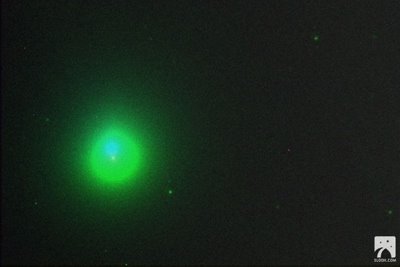
2006-10-16
Asteroid 7 Iris -- Surprisingly Bright
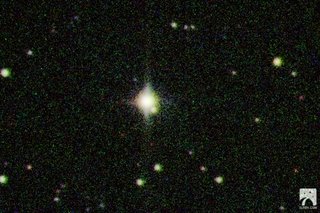 I logged onto Slooh.com and enjoyed a great radio show by the "Divas" - Marleen and Tavi. While they talked, the telescope zoomed in on Iris.
I logged onto Slooh.com and enjoyed a great radio show by the "Divas" - Marleen and Tavi. While they talked, the telescope zoomed in on Iris.I'm not a big observer of asteroids. They usually look like nothing more than a dim star. But not with Iris. Right now we are fairly close to Iris, so it was surprisingly bright -- well, surprisingly to me!
2006-10-14
Comet Faye Moves On
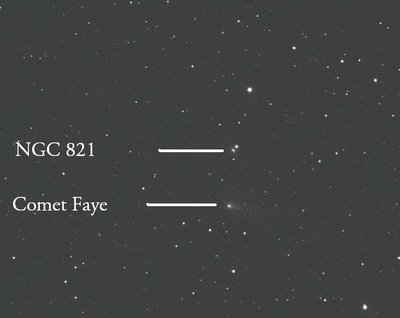
Comet Faye passed by the field of view with a galaxy over a period of a few days in October.
These two photos show the motion, relative to the somewhat indistinctive galaxy NGC 821. This photo also shows how a comet hunter can easily mistake a small fuzzy object with a galaxy or nebula.
The first photo was taken on October 11, 2006, at 2130 UTC, using 14-inch diameter Schmidt Cassegrain Telescope, with a 3910mm focal length, and a magnification of 470. The photo does not show the galaxy very well, but in larger images it does show up as a fuzz-ball that is somewhat smaller in appearance than the comet.
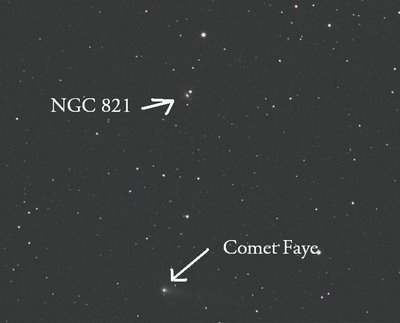 The second image was taken with the same telescope, set on the exact same coordinates (Right Ascension 2 hours, 8 minutes and Declination 10 degrees 47' 27"). The second image was taken on October 13th at 2332 UTC.
The second image was taken with the same telescope, set on the exact same coordinates (Right Ascension 2 hours, 8 minutes and Declination 10 degrees 47' 27"). The second image was taken on October 13th at 2332 UTC.Seeing was at 4.5 for both nights (4 out of 5). Examining the stars in the background, the conditions seem to be identical.
2006-10-10
Neptune's Motion Through The Skies
Seeing was poor on the first night (1.7 out of 5), but exellent on the second night. I have drawn a line in a pattern of stars to show the movement of Neptune from October 4th through October 9th.
Double click the image for a larger view of the photos.

2006-10-07
Comet c/2006 T1 (Levy)
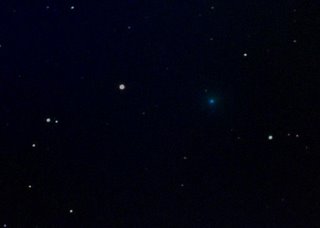 David Levy has discovered a new comet -- I believet his makes 22 discoveries for him!
David Levy has discovered a new comet -- I believet his makes 22 discoveries for him!I observed the comet last night, and even with a full moon I was able to spot it and take this 5 minute exposure photo. The equipment used was a 14 inch Schmidt Cassegrain.
You can barely see it -- but it is there. It shows up as a bluish haze. I could not see a distinct tail at all.
The positions for the comet for the next few evenings will be:
2006 10 07 09 55.04 +12 56.6This ephemeris comes from http://cfa-www.harvard.edu/iau/Ephemerides/Comets/2006T1.html
2006 10 12 10 13.68 +09 39.4
2006 10 17 10 31.47 +06 23.1
2006 10 22 10 48.44 +03 10.2
2006 10 27 11 04.65 +00 02.5
2006 11 01 11 20.16 -02 58.4
2006 11 06 11 34.99 -05 51.6
2006 11 11 11 49.19 -08 36.6
2006 11 16 12 02.79 -11 13.0
2006 11 21 12 15.80 -13 40.8
2006 11 26 12 28.23 -15 59.9
2006 12 01 12 40.09 -18 10.7
2006-09-25
My New PST for Observing the Sun
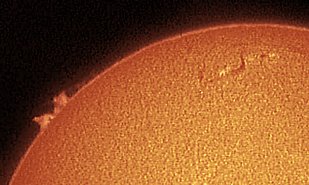
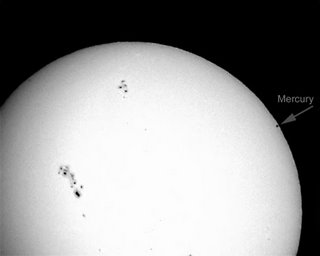
Which view of the sun would you rather have? On the bottom is a photoI took during the 1999 Mercury transit, using a 3.5 Questar, one of the best Maksutov-Cassegrain telescopes available. It is a great shot, but besides tiny Mercury, all you see is a nice complex of sunspots. The problem is that even with the excellent filter of the Questar, you are looking at the sun in White Light. In order to see solar prominences and filaments you have to look at the sun in H-Alpha.
The other photo is one I took this week using a new telescope.
Questar does a nice job with sun spots, but I wanted to see prominences, filaments, plage and flares -- and sunspots. The picture below was found on www.coronadofilters.com.
Coronado produces PSTs, or Personal Solar Telescopes-- a wonderful telescope for solar viewing.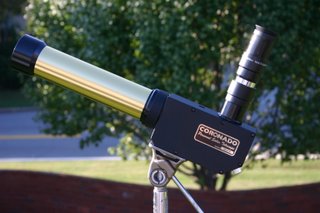 PSTs allow a person to view the sun in the H-Alpha bandwidth of the spectrum. Questar offered an H-Alpha filter. The only problem is that it costs about $6,000 to add this to an existing Questar telescope.
PSTs allow a person to view the sun in the H-Alpha bandwidth of the spectrum. Questar offered an H-Alpha filter. The only problem is that it costs about $6,000 to add this to an existing Questar telescope.
Coronado offers a much more affordable option. Their PSTs don't have a lot of power and magnification, but when looking at the sun it is not magnification you need as much as the filter.
I ordered one of these PSTs. It came on Monday.
I woke up on Monday,  knowing it would arrive sometime during the day, and was distressed to see the gray clouds covering the sky. But by 9 AM, the sky went from cloudy to clear blue within a short time -- like a curtain being opened.
knowing it would arrive sometime during the day, and was distressed to see the gray clouds covering the sky. But by 9 AM, the sky went from cloudy to clear blue within a short time -- like a curtain being opened.
I had a chance to spend a couple of hours playing with my new toy.
The PST is simple to use. The instruction manual is really just a small single sheet, making a tri-fold pamphlet. There is not much to know about how to use it. However, I did come to appreciate what the tiny instruction manual meant when it said, "It can take time to 'train' one's eye for H-Alpha viewing." My first reaction to looking through the telescope was disappointment. All I saw was an orange-red sphere. It took a while to understand how to look through the new telescope.
The PST is simple to use, even more so that a Questar. When I use the Questar to look at the sun, I have to screw in the solar filter and remember to flip the hinge operated, built-in solar filter over the view finder. (Johnny Carson is responsible for that addition to Questar. He was an avid astronomer and when he bought his Questar in the early 1960's he personally complained about the danger of not having a built in solar filter for the view finder).
With the PST, the filter is built in. Period.
Coronado has also come up with a special view finder. There is a pinhole-size opening in the base of the telescope that reflects the sun's image on a screen.
After putting it on the tripod, I located the sun using a special view finder Coronado has devised.
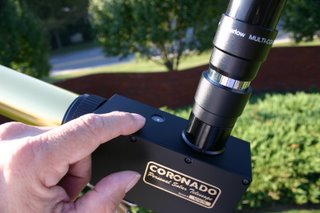
As you can see in the picture above, the tiny, circular screen shows a tiny solar image. Center that and the sun should be visible in the eyepiece. It is handy, in that you can move the telescope's position and look through the eyepiece while keeping the other eye open to look at the view finder screen.
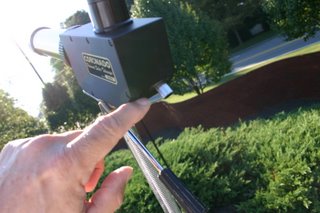
The focus knob, shown here, is conveniently located. To focus the PST, don't look at the body of the sun, but along the limb. When the limb is sharp, the telescope is in focus.
My initial disapointment is that nothing came into view once I focused the telescope.
The instructions provided by Coronado says that there is another important adjustment the observer can make, in addition to focusing.
It is a knob encircling the tube of the telescope called the tuner -- something not found on other telescopes. It rotates or tunes the filter. Coronado adjusts this at their factory and says that you normally would never need to adjust the tuner. After several minutes of being frustrated with nothing to really see, I dared to adjust the tuner.
Everything came into view! There were prominences and filiments all over the surface of the sun. The entire sun had a distinct texture to it.
This telescope was reviewed in Sky and Telescope magazine a year or two ago, and the reviewer's main criticism is what Coronado calls the "sweet spot." When the telescope is tuned and focused, the eye will see filiments and prominences in the "sweet spot" of the eyepiece. As the earth turns and the sun seems to move out of the view of the telescope, those solar features will appear to grow and then disappear.
It takes a while to become accustomed to the sweet spot, and I don't pretend that I have gotten used to it after only two days.
The closest I can compare it with is looking at Andromeda Galaxy, M-31. That dark sky object is visible with the unaided eye -- or was before all the street lights were set up. Even in a rather small telescope, the image is so large that the best way to look at it is to turn off the clock-drive and let the earth's rotation turn the telescope so that the image slowly comes into and then out of view while the observer just sits there and watches the show.
Setting the telescope on the edge of the sun the observer can watch the sun come in and then out of view. The sweet spot will highlight different features on the face of the sun.
It is taking some time to master photography with the PST -- this image here is my very first attempt. It shows a prominence along the limb, or edge, of the sun, but it doesn't to justice to what I actually saw. The more recent photos are a vast improvement over this first try.
The PST comes with a single eyepiece, a 20mm (20x) 1.25" Kellner. I added a 2x Barlow and enjoyed the viewing much more with the increased power. Coronado recommends buying their eyepieces, but I found that any of my 1.25" occulars were good.
Amateur astronomers are not usually as interested in magnification as the general public, because there are other things more important to us, such as resolution. Still, the question is a good one -- what is the magnifying power of the PST?
The formula to calculate a telescope's magnification power is M= fe/fo, or magnifcation equals fe, which is the focal length of the eyepiece, divided by fo, which is the focal length of the objective lense. The PST has a focal length of 400mm. Using the 20mm eyepiece, that is a small magnification power of only 20x. The barlow I have is a 2x, which increases the power by having a deminishing effect on the eyepiece focal length. In other words, the 2omm eyepiece with a barlow becomes a 10mm eyepiece -- resulting in a magnification of 40. It is still small, but sufficient for the sun. I have a 12.5mm eyepiece, which is the smallest I have -- so with a 2x barlow, that becomes a 8.25mm for a power of roughly 48.5. That's quite a bit different from the magnification of my 3.5 Questar, with which I can achieve a magnification of about 360x, or the 10 inch reflector I have that can reach about the same, but captures more light.
But I digress.
Getting back to the PST, I was particularly pleased with the video images I took using a Meade electronic eyepiece -- it has a 320x240 pixel CMOS monocrome imaging sensor. Even though it records the image in black and white, the detail of the image was better than I was able to get on the first several tries I made with the digital still-camera.
Last night was a clear night, so I continued to take a few photos of the from Arp's Atlas of Peculiar Galaxies. Below is Arp 049, NGC 7545. The duration of the image was ten minutes, and it still is a bit of a disappointment.
Next is Arp 28, NGC 7678.
NGC7678 is a face-on spiral galaxy in Pegasus. it has an arm that is nearly as massive as the rest of the galaxy, which I believe is why Arp included it in his list.
2006-09-16
Arp Galaxy 337
NGC 3034 is bright enough to be in Charles Messier's catalog as M82. It is often referred to as the "Cigar Galaxy" and it certainly appears to deserve its name.
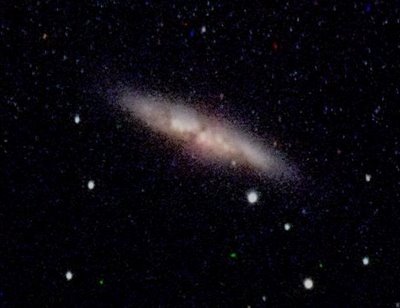
M81 and its neighbor M82 form a striking pair in the small telescope. M82 is being physically affected by its bigger neighbor. Tidal forces caused by gravity have deformed th eM81 galaxy, a process that started roughly 100 million years ago. This interaction has caused star formation to increase 10 fold compared to "normal" galaxies. At present the centers of M81 and M82 are about 150,000 light-years apart.
Here is a photo I took of M81 a few years ago.
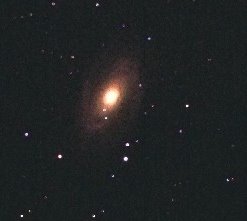
M82 is the type example of an Irr-II -- Irregular galaxy type II, meaning the disk is irregular. Recent studies, however, suggest that it may actually be a barred spiral galaxy seen edge on from earth.
Of course, as good as I think I did, NASA did better with the Hubble Space Telescope!

Observation notes:
2006 September 16, 23 hours 02 minutes local time.
Sky -- excellent. 4 out of 5. Dark sky.
5 minute exposure on 3 megapixel CCD.
14 inch Schmidt Cassegrain Telescope with 3910mm focal length.
Stephen's Quintet -- Arp Peculiar Galaxy # 319

Stephen's Quintet is another very tough challenge to find and photograph.
The quintet is a prototype of a class of objects known as compact groups of galaxies and has been studied intensively for decades.
As its name implies this is a group of five galaxies (NGC7317, 7318A, 7318B, 7319 and 7320) and lies about 270 million light-years away in the constellation of Pegasus (North-west of the Great Square of Pegasus).
The galaxy group discovered by the French astronomer Edouard Stephan in 1877, using the Foucault 80-cm reflector at the Marseilles Observatory -- and it was the first such grouping to be found. Today we know of hundreds of similar groupings, but few are as spectacular as Stephan's Quintet.

Observation notes:
2006 September 16, 19 hours 37 minutes local time.
Sky -- excellent. 4 out of 5. Dark sky.
5 minute exposure on 3 megapixel CCD.
14 inch Schmidt Cassegrain Telescope with 3910mm focal length.
Arp Galaxy 728
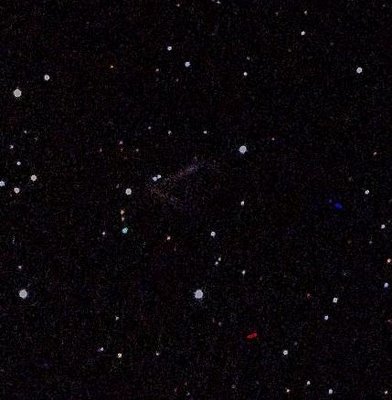
The top image was taken on September 4th, with a 12 day moon -- pretty close to full. The bottom image was taken on September 16th, with a 24 day moon -- still fairly bright, but not so bad.
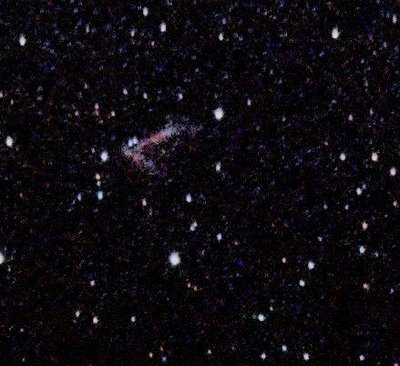
The galaxy has a "V" shape to it.
This pair of 14th-magnitude galaxies lies in northwestern Pegasus, about 200 million light-years away. In the image, NGC 7253 B is the larger galaxy nearer the top, and NGC 7253 A is the smaller one, apparently on the bottom from this view point.
Observation notes:
2006 September 16, 22 hours 52 minutes local time.
Sky -- excellent. 4.5 out of 5. Dark sky.
5 minute exposure on 3 megapixel CCD.
14 inch Schmidt Cassegrain Telescope with 3910mm focal length.
Arp Peculiar Galaxy # 225
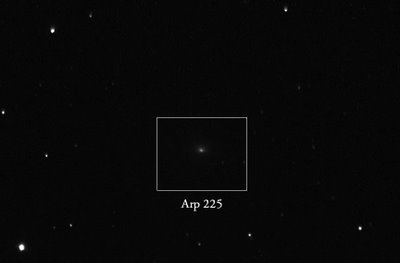
I should visit this galaxy again later on -- I simply did not get a good image tonight. It is a 3 minute exposure and it needed a longer period.
Observation notes:
2006 September 16, 20 hours 15 minutes local time.
Sky -- excellent. 4 out of 5. Dark sky. No moon.
5 minute exposure on 3 megapixel CCD.
14 inch Schmidt Cassegrain Telescope with 3910mm focal length.
Arp Peculiar Galaxy # 169

I have inverted the image so the galaxies stand out a bit.
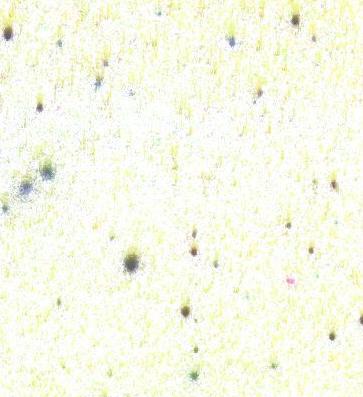
Observation notes:
2006 September 16, 19 hours 30 minutes local time.
Sky -- excellent. 4 out of 5. Dark sky. No moon.
5 minute exposure on 3 megapixel CCD.
14 inch Schmidt Cassegrain Telescope with 3910mm focal length.
Arp Peculiar Galaxy # 112

Arp 112 is a very dim, difficult galaxy to photograph. It is more commonly known as NGC 7805 and NGC 7806. NGC 7806 is particularly dim. Because this pair is so dim, I am only posting an inverted image. The fuzzy star next to NGC 7805 is simply that, a star that simply appears fuzzy.
Observation notes:
2006 September 16, 21 hours 50 minutes local time.
Sky -- excellent. 4 out of 5. Dark sky. No moon.
5 minute exposure on 3 megapixel CCD.
14 inch Schmidt Cassegrain Telescope with 3910mm focal length.
Arp Peculiar Galaxy # 86
Arp realized that the reason why galaxies formed into their usual shapes of spiral or elliptical patterns was not understood by astronomers. With this atlas, astronomers had a sample of peculiar galaxies that they could study in more detail. The atlas is not a complete overview of every peculiar galaxy in the sky and does not intend to be -- but it does provide examples of the different phenomena as observed in nearby galaxies.
Because little was known at the time of publication about the physical processes that caused the different shapes, the galaxies in the atlas are sorted based on their appearance.
Objects 1-102 are individual peculiar spiral galaxies or spiral galaxies that apparently have small companions.
Objects 102-145 are elliptical and elliptical-like galaxies.
Objects 146-268 are individual or groups of galaxies with neither elliptical nor spiral shapes.
Objects 269-327 are double galaxies.
Finally, objects that simply do not fit into any of the above categories are listed as objects 332-338.
Most objects are best known by their other NGC numbers, Messier numbers or other catalogue listing, but a few galaxies are best known by their Arp numbers, such as Arp 220.
There is better understanding today about the physical processes that lead to the peculiarities seen in the Arp atlas. A large number of the objects are interacting galaxies, including Arp 85, Arp 220, and Arp 244.
A few of the galaxies are simply dwarf galaxies that do not have enough mass to produce enough gravity to allow the galaxies to form any cohesive structure. NGC 1569 or Arp 210 is an example of this.
A few others are radio galaxies -- these contain active galactic nuclei that produce powerful jets of gas called radio jets. The atlas includes the nearby M87, or Arp 152, as one of these radio galaxies.
Here is a photo of Arp #86 I took this evening. More commonly called NGC 7753, this is a spiral galaxy with a small nucleus and a small bar. NGC 7752 is a close companion that is apparently attached to one of NGC 7753's spiral arms. It was first thought to be an elliptical galaxy, but later images show that it is an irregular and disrupted system with three major H-{alpha} areas. The pair seem to have recently collided and are very similar to the M51 galaxy pair.
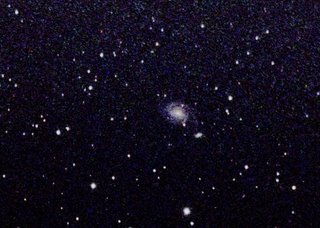
This pair is included in Arp’s catalog of unusual galaxies as ARP 86. The system is in Arp's class "spiral galaxies with large high surface brightness companions on arms".
I inverted the colors on the photo -- an old astronomer's trick that brings out some of the hard-to-see details. The smaller galaxy is more easily seen in the inverted image.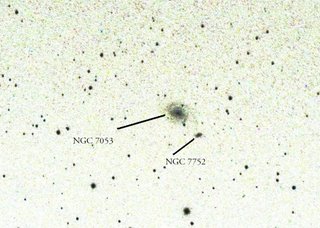
Observation notes:
2006 September 16, 22 hours 52 minutes local time.
Sky -- excellent. 4.5 out of 5. Dark sky. No moon.
5 minute exposure on 3 megapixel CCD.
14 inch Schmidt Cassegrain Telescope with 3910mm focal length.
2006-09-14
Another Look at Comet Faye 4P

This was taken with a 14 inch Schmidt Cassegrain with a focal length of 3910mm. The image was taken with a 5 minute exposure using a CCD with 3 megapixels.
As often happens with comets, the lesser power gathers more light from the tail. Here is a shot taken with a 85mm APO refractor with a 480 mm focal length.
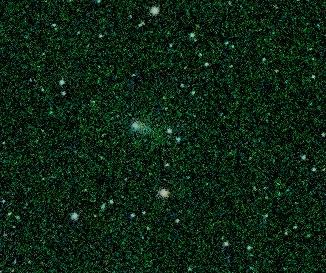
The image is not as good and clear, but the tail shows up better.
Faye was discovered in 1844 and has a short 7.5 orbital period.
For my previous observation, go to:
http://myquestar.blogspot.com/2006/08/comet-faye-4p.html
2006-09-02
3200 Phaethon

Comet: 3200 Phaethon
Date and Time: 2 September 2006
2302 UTC
Observing Location: Lawrenceville GA
Instrument: First photo used a 14 inch Schmidt-Cassegrain Telescope with 3910 focal length.
The second image used a 34 mm reflector with 135 mm focal length. Skies were excellent. It shows the comet with a highlighted circle.

I felt the tail was clearer in the lower powered telescope. The nucleus is bright. Tail is hazy, but it is clearly a tail that is on one side of the comet rather than a hazy surrounding a star-like object.
2006-08-31
Comet Faye 4P
Date and Time: 30 August 2006 2307 UTC
Observing Location: Lawrenceville GA
Instrument: 14 inch Schmidt-Cassegrain Telescope with 3910 focal length
Conditions: Clear Skies, Sky & Star Steadiness: 1
These pictures show the very dim comet. Through the eyepiece, there is a distinct coma, though dim. These photos are identical, with the addition of a circle in the second image to highlight the comet.


2006-07-25
Comet - Barnard 2 177
 Comet: Barnard 2 177
Comet: Barnard 2 177Date and Time:
25 July 2006 UTC 1717
Observing Location:
Lawrenceville GA
Instrument:
14 inch Schmidt-Cassegrain Telescope with 3910 focal length
With good skies. IC 1236 is seen in the upper left corner of photo.
